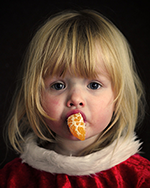Language development
The development of language is essential for a child to interact and communicate with others. From birth the newborn starts to make sounds, cooing and crying. This develops over the first few months of life as the throat matures physically and sounds become more refined.
The ability to understand what is said appears to develop first in babies and young children and is followed by the ability to say and use language. For example, at 6 months a baby starts to babble, imitate sounds and make gestures. Typically, around 12 months the first understandable word is said. By 18 months, a young child understands around 50 words, but uses only 20. From here single words become 2 word phrases and the child uses telegraphic speech, for example, “more milk”. By 5 years, speech is becoming clearer and the child typically asks the meaning of words they don’t know. The ability to use grammar is improving and past tenses, plurals, "me" and "I" are used properly.
As school age children continue to use verbal language and learn to read and write there is an increasing ability to use language to explain and articulate situations, thoughts, feelings and experiences. Adolescents will often use language in a subversive way, creating new words and phrases as a method of identity.




